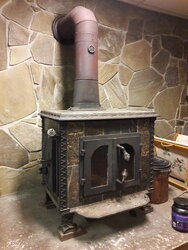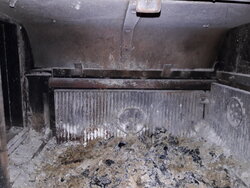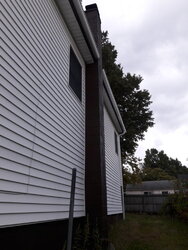Hi all,
I'm a new wood stove owner trying to do his homework. I have a lot to learn.
I bought a house with an old Hearthstone H1 in the basement (the upstairs has gas heat, but not the finished basement). About 1000 square feet up and down. I replaced the glass and gaskets (both needed doing) last winter. I've had trouble running it. It's tough to get a fire going without smoking up the place. Once I do, it burns through wood very fast, and doesn't burn very well at all unless I keep the door cracked. I'm just shoveling wood into it constantly. While it appears to be in good shape (no evidence of overfiring), I understand this just isn't a very efficient stove. I used it a few times last winter before consigning myself to just not using the basement much in the winter months. It has no blower. It helps if I crack a window.
So question 1 is: is there something I should do to make this more efficient / productive, or am I right to replace it? From what I've read here I'd be much better off with a newer model. That's what I'm planning on unless I'm missing something.
Question 2 has to do with installation. The H1 already installed takes a 8" pipe. Most models I've been looking at (mostly Englanders by this site's general recommendation) take a 6" pipe. Is this just a matter of connecting an adapter, or do I need a new stove pipe? Or something else (work in the chimney itself)? The current stove is connected via a 90 degree pipe that goes into a masonry chimney.
Question 3 is also an installation question. I don't have a lot of money to throw around. I'd like to buy a used stove and install it myself, (and if possible sell the H1). It appears to be fairly simple... connect the new stove to the pipe. Mine looks like it's just screwed together. Maybe some sealant. Is this a reasonable undertaking or am I asking for trouble doing it myself? Can anyone recommend any good guides to doing this? If it's inadvisable, can you give me an idea of what it would cost to have someone do it? I already talked to my home insurance provider and they told me I could install it myself if I wanted to.
I hope these questions aren't too stupid... if they are, please understand that I'm trying to educate myself and that's why I'm asking them. Happy to provide any further information that might help. Thank you!
I'm a new wood stove owner trying to do his homework. I have a lot to learn.
I bought a house with an old Hearthstone H1 in the basement (the upstairs has gas heat, but not the finished basement). About 1000 square feet up and down. I replaced the glass and gaskets (both needed doing) last winter. I've had trouble running it. It's tough to get a fire going without smoking up the place. Once I do, it burns through wood very fast, and doesn't burn very well at all unless I keep the door cracked. I'm just shoveling wood into it constantly. While it appears to be in good shape (no evidence of overfiring), I understand this just isn't a very efficient stove. I used it a few times last winter before consigning myself to just not using the basement much in the winter months. It has no blower. It helps if I crack a window.
So question 1 is: is there something I should do to make this more efficient / productive, or am I right to replace it? From what I've read here I'd be much better off with a newer model. That's what I'm planning on unless I'm missing something.
Question 2 has to do with installation. The H1 already installed takes a 8" pipe. Most models I've been looking at (mostly Englanders by this site's general recommendation) take a 6" pipe. Is this just a matter of connecting an adapter, or do I need a new stove pipe? Or something else (work in the chimney itself)? The current stove is connected via a 90 degree pipe that goes into a masonry chimney.
Question 3 is also an installation question. I don't have a lot of money to throw around. I'd like to buy a used stove and install it myself, (and if possible sell the H1). It appears to be fairly simple... connect the new stove to the pipe. Mine looks like it's just screwed together. Maybe some sealant. Is this a reasonable undertaking or am I asking for trouble doing it myself? Can anyone recommend any good guides to doing this? If it's inadvisable, can you give me an idea of what it would cost to have someone do it? I already talked to my home insurance provider and they told me I could install it myself if I wanted to.
I hope these questions aren't too stupid... if they are, please understand that I'm trying to educate myself and that's why I'm asking them. Happy to provide any further information that might help. Thank you!




